The HTC One (M8) Review
by Anand Lal Shimpi & Joshua Ho on March 26, 2014 7:00 PM EST- Posted in
- Smartphones
- HTC
- Mobile
- HTC One
Battery Life
The new One features an integrated 3.8V 2600mAh battery (9.88 Wh), a 13% increase in capacity compared to the previous model. The battery comparison isn’t that simple however. The M8 has a larger display (5” vs 4.7”) but it also has a higher performing and more power efficient SoC (Snapdragon 801 vs. 600). To find out how the new One stacks up against its predecessor, we turn to a mix of old and new battery life tests to help better characterize the device.
We’ll start with our standard browser based battery life tests. Keep in mind here these tests are as much about replicating a particular CPU profile as they are about loading specific web pages in order.
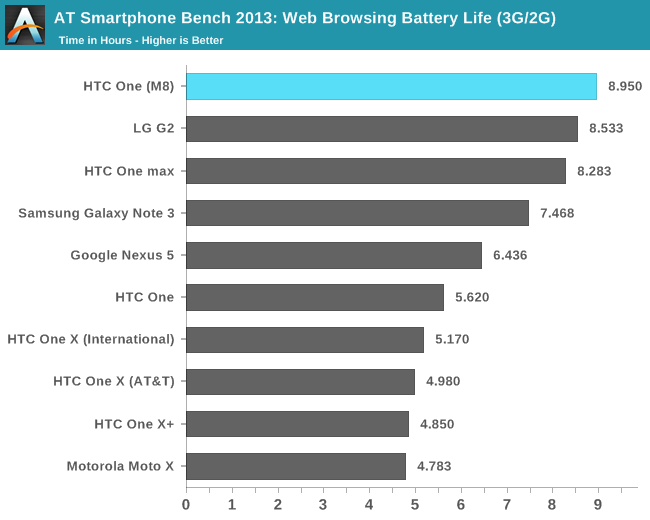
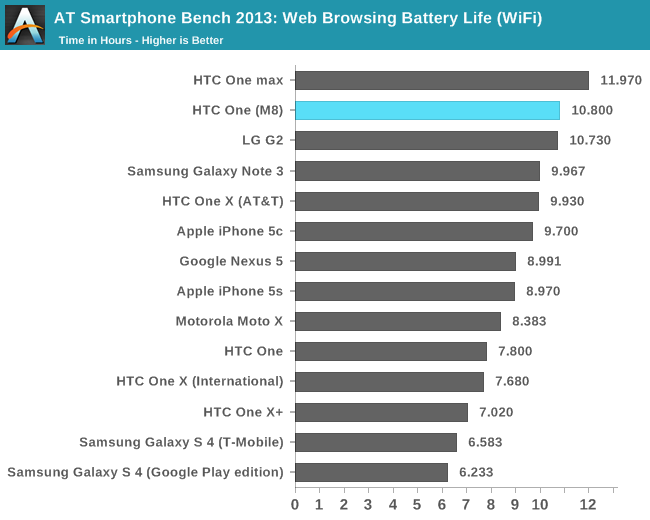
We saw a substantial gain in battery life with Snapdragon 800, and 801 extends that even further. For the same, relatively light (yet constant) workload, the M8 improves battery life over the M7 by as much as 71%. On WiFi the advantage drops to only 38%, but we’re still talking about absolutely huge generational gains.
A constant workload is only one part of the story though. More often than not, when you’re faced with faster compute you end up doing more. To see what the other extreme of battery life looks like I turned to two canned tests: BaseMark OS II and GFXBench 3.0.
I ran both of these tests under the same controlled conditions we always use, with all displays calibrated to 200 nits. BaseMark OS II runs through a bunch of CPU and storage benchmarks (basically the same tests used for the BaseMark OS II system and memory tests), as fast as possible, until the battery dies.
I like this benchmark as it gives us an indication of worst case battery life if you’re absolutely hammering the CPU (and storage) relentlessly.
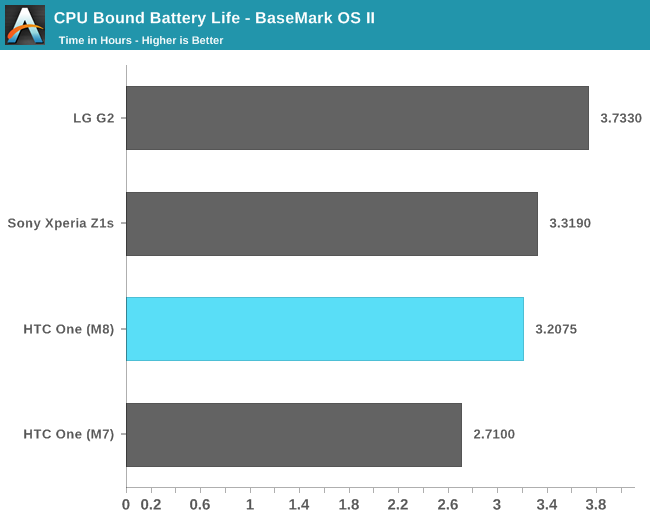
Despite the faster CPU cores, the M8’s battery life actually goes up compared to M7. Here we’re really seeing the benefits of 801’s updated 28nm HPm process compared to the Snapdragon 600’s 28nm LP process.
GFXBench provides a similar test, with effectively uncapped performance (on today’s devices at least since we’re not hitting v-sync limits), but stressing the GPU instead of the CPU. Here we’re running the T-Rex HD benchmark, onscreen, until the battery dies.

This is the first and only test we’ve got here that shows a regression in battery life compared to M7. The M8 loses about 6% of runtime compared to the M7, despite having a larger battery. Now look at what happens if we look at performance at the end of the run:
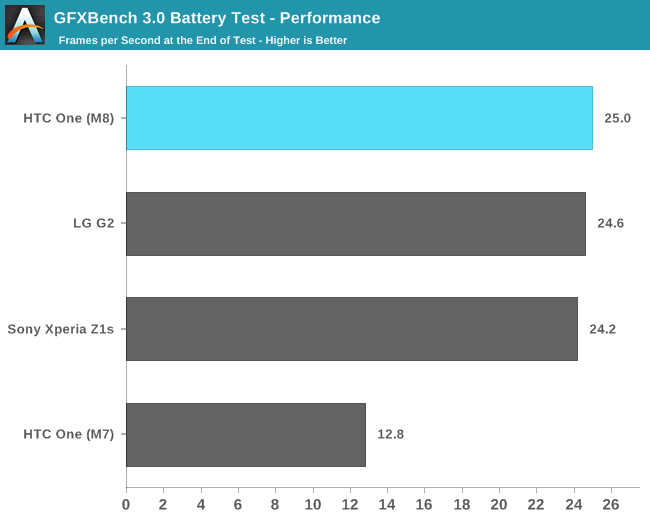
Now the M8’s battery life regression doesn’t look so bad. You give up 6% of runtime but you get almost twice the performance compared to M7. Snapdragon 801 is just a huge upgrade compared to 600.
Charge Time
The M8 features a Qualcomm Quick Charge 2.0 enabled PMIC, which enables faster battery charge times through higher voltage charging. Unfortunately the in-box wall adapter is only Quick Charge 1.5 compliant so you'll only pull 7.5W from the wall. HTC expects to offer a Quick Charge 2.0 compliant power adapter later this year.
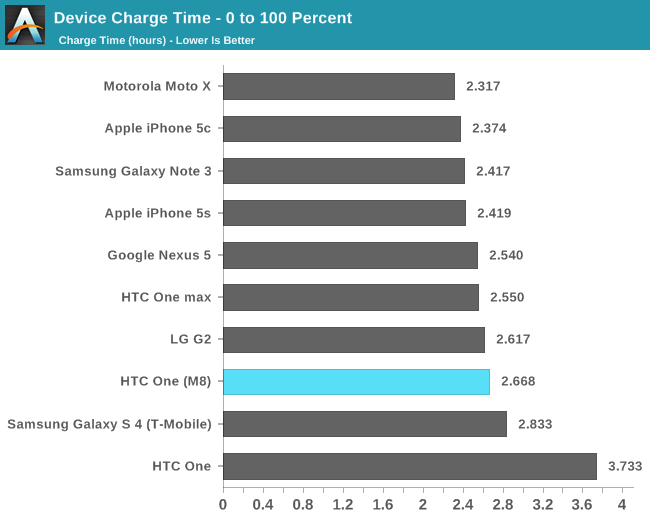
The M8's charge time is a bit slow compared to what we've seen from other devices with larger batteries.










222 Comments
View All Comments
doosh bag - Thursday, March 27, 2014 - link
In order for HTC to build this phone with the "6-8 megapixel" people keep screaming they can't live without, they would've had to raise the price considerably to make the phone profitable. Don't forget HTC's revenues were down almost 50% in Q4 2013 from Q4 2012. It's quite easy for people to sit around in the comment box of someone else's blog and wax intellectual about how to spend HTC's money. If this phone sells like the M7, we may not see a M9.Death666Angel - Friday, March 28, 2014 - link
Lose the second camera, lose the expensive all metal unibody, which obviously people don't need (look at other top selling smartphones) and give me the 6-8MP Ultrapixel sensor for the same price. There, I solved your problem. Now HTC has just done "more of the same" while giving us "less of some stuff". Of a phone that probably wasn't a big hit, or else they would be doing better. I don't understand their strategy at all.evonitzer - Saturday, March 29, 2014 - link
Heck, lose the 801 (who needs that performance anyway), lose the Wifi AC (impossible to find in the wild), cut the screen resolution (nobody needs more than qHD say I) ... what else can I cut and still have a phone? LTE! Get rid of it.Seriously, what's the point of innovating or trying. Just be boring and people will buy it.
jospoortvliet - Sunday, March 30, 2014 - link
I sure as he'll wouldn't have bought it if it was another plasticy piece of crap like the Samsung's... Their strategy is fine, they just need more/better priced midrange phones.hero4hire - Sunday, March 30, 2014 - link
Exactly. It's not like the consumer is footing the bill for the all metal vs plastic. If there was a tradeoff for metal & 4mp or vs plastic 16mp "ultra" it would be worth a discussion. Maybe they could make that phone too. I d bet we find s5 and one (2014) for the same USA subsidy price as is.CoryWeston101 - Monday, March 31, 2014 - link
Cut the metal unibody? You are a daft one.LAWSON72 - Wednesday, March 26, 2014 - link
S5 for water proof and less to worry about since it is plastic, or this for the beautiful metal design, and touchscreen nav buttons. A tough decision, I just know I am getting bored with my S4 and the Nexus 5 sadly is not ever going to be on Verizon, so it is a choice between these two.antef - Wednesday, March 26, 2014 - link
Curious why you're "happy to see a move to nano sim as well." What difference or advantage does it make for the consumer? They can be harder to find on pre-paid carriers. Seems like it only exists due to Apple's relentless desire to always be using something different from everyone else.Braumin - Wednesday, March 26, 2014 - link
Simple. Nano sim in this case made room for dual sim on some models, and likely freed up space for micro SD, although making the body taller likely helped too.Plus the nano sim was made a standard so why not? You can make the argument it's the wrong standard, but it won out.
antef - Thursday, March 27, 2014 - link
I don't think "micro SIM being too big" was ever a reason for excluding things like micro SD slots, that decision is mostly made for other reasons and HTC probably just included it this time to try to differentiate some. I'm okay with a new standard if it's universally available, but until recently and maybe even now that hasn't been the case (again regarding pre-paid carriers).